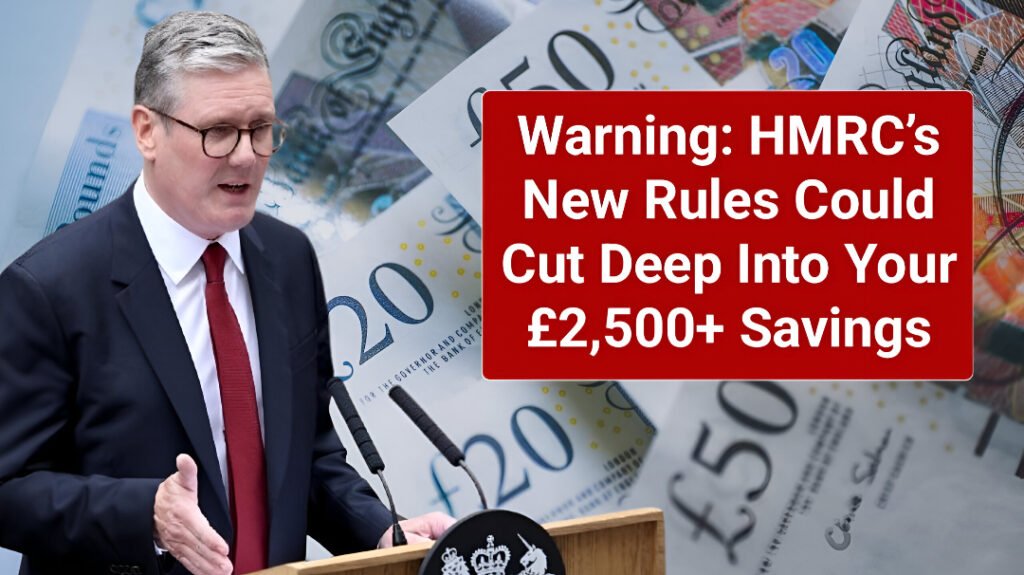Hello Everyone, The UK tax system is changing again, and this time, it could directly impact the savings of thousands of people. HMRC (Her Majesty’s Revenue & Customs) has recently introduced new rules that may reduce how much of your savings you get to keep. For many households, particularly those with £2,500 or more set aside, these changes might mean a noticeable cut in income.
So, what exactly has changed, why is HMRC making these moves, and how can you protect your money? Let’s break it down in simple terms so you know what to expect.
What Are the New HMRC Rules?
The latest update focuses on savings income, personal allowances, and how interest earnings are taxed. Until now, many savers benefited from tax-free allowances like the Personal Savings Allowance (PSA). This allowed basic-rate taxpayers to earn up to £1,000 in interest tax-free each year.
But under the new rules, HMRC is tightening its grip. For those with savings above £2,500, more interest may now fall into taxable income. That means money you thought was safe and growing quietly in your bank could suddenly attract a tax bill.
Why Is HMRC Making These Changes?
The government has been looking for ways to increase tax revenues. With inflation rising, interest rates going up, and more people holding cash in savings accounts, HMRC sees this as an opportunity to collect more from savers.
In short, when your bank pays you higher interest, HMRC wants a bigger slice of that pie.
Who Will Be Most Affected?
Not everyone will feel the pinch immediately. But here’s a breakdown of who should be concerned:
-
Basic-rate taxpayers: If your savings generate more than £1,000 in interest annually, you’ll now face tax on the extra.
-
Higher-rate taxpayers: You only get a £500 PSA, so any savings above that will be taxed.
-
Additional-rate taxpayers: Unfortunately, you don’t get a PSA at all—every bit of savings interest is taxable.
-
Pensioners: Retirees who rely on savings to top up their pension income may be hit hardest, as many have £2,500+ set aside for emergencies.
How Much Could You Lose?
Let’s put it into perspective. Suppose you’ve got £25,000 in savings with a 5% interest rate. That’s £1,250 in interest per year. Under the new rules:
-
If you’re a basic-rate taxpayer, only £1,000 is tax-free. The remaining £250 is taxable at 20%, meaning you’ll lose £50 to HMRC.
-
If you’re a higher-rate taxpayer, just £500 is tax-free. That means £750 is taxable at 40%, costing you £300.
-
If you’re an additional-rate taxpayer, the entire £1,250 is taxable at 45%, which means a £562.50 tax bill.
For pensioners or those on fixed incomes, this isn’t small change—it’s money that could have been used for bills, groceries, or energy costs.
Impact on Pensioners and Retirees
This rule change is particularly worrying for older savers. Many pensioners have built up emergency funds or use savings to cover healthcare and household expenses. With higher interest rates, they may earn more on paper, but after HMRC takes its share, the benefit is reduced.
It’s also worth noting that pensioners may already be close to the income tax threshold. Even modest savings interest could push them over the line into taxable territory.
Are ISAs Still Safe?
Yes—Individual Savings Accounts (ISAs) remain one of the best ways to shield your money from HMRC. The rules around ISAs haven’t changed, meaning all interest earned inside them is still tax-free.
If you haven’t maxed out your ISA allowance (£20,000 per year), now is the time to do so. Moving your savings into an ISA can protect you from these new rules.
How to Protect Your Savings
If you’re worried about losing part of your savings to HMRC, here are some smart steps to consider:
-
Use ISAs: Shift savings into Cash ISAs or Stocks & Shares ISAs.
-
Check your PSA: Make sure you know how much tax-free interest you’re entitled to.
-
Split savings with a partner: Married couples can sometimes reduce tax liability by spreading savings.
-
Review your accounts: Some banks may offer ISA-linked products or higher-interest tax-free options.
-
Seek advice: If you’re unsure, a financial advisor can help you structure your savings in the most tax-efficient way.
Why You Should Pay Attention Now
Many people think tax changes only affect the wealthy, but this isn’t true here. Even middle-income savers with modest accounts could see HMRC eating into their money.
The timing also matters—interest rates are higher now than they’ve been in years, which means your savings are finally growing again. But unless you act smartly, much of that growth could end up in HMRC’s hands instead of yours.
Final Thoughts
HMRC’s new rules may look small on paper, but the reality is they could cut into the savings of millions of UK households. If you’ve got more than £2,500 put aside, it’s time to review how your money is structured.
Using ISAs, spreading savings across accounts, and understanding your allowances can make all the difference. With the right planning, you can still hold on to most of your hard-earned money.
At the end of the day, your savings are meant to give you security and peace of mind—not extra stress from unexpected tax bills. By staying informed and proactive, you can make sure HMRC’s new rules don’t take more than they should.
